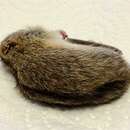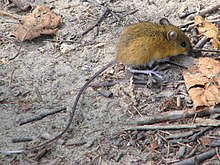ar
الأسماء في صفحات التنقل


Els dipodoïdeus (Dipodoidea) són una superfamília de rosegadors que inclou els ratolins saltadors i els jerbus. Els animals d'aquest grup aparegueren per primera vegada al registre fòssil a mitjans de l'Eocè, fa aproximadament 45 milions d'anys.[1] El clade inclou una família vivent, la dels dipòdids, i una d'extinta, la dels simímids. Aquest últim grup, que visqué al sud i l'oest del que avui en dia són els Estats Units durant l'Eocè, també ha sigut classificat com a cricètid o com a muroïdeu incertae sedis, però la morfologia del zigomasseter i la semblança de les seves dents molars amb les dels zapodins primitius fan que encaixi millor dins el grup dels dipodoïdeus.[2] S'ha assignat una segona família extinta (Armintomyidae) a aquest grup amb un menor grau de certesa.
Els dipodoïdeus (Dipodoidea) són una superfamília de rosegadors que inclou els ratolins saltadors i els jerbus. Els animals d'aquest grup aparegueren per primera vegada al registre fòssil a mitjans de l'Eocè, fa aproximadament 45 milions d'anys. El clade inclou una família vivent, la dels dipòdids, i una d'extinta, la dels simímids. Aquest últim grup, que visqué al sud i l'oest del que avui en dia són els Estats Units durant l'Eocè, també ha sigut classificat com a cricètid o com a muroïdeu incertae sedis, però la morfologia del zigomasseter i la semblança de les seves dents molars amb les dels zapodins primitius fan que encaixi millor dins el grup dels dipodoïdeus. S'ha assignat una segona família extinta (Armintomyidae) a aquest grup amb un menor grau de certesa.
De jerboä's (wittenskiplike namme: Dipodoidea) foarmje in boppefamylje fan 'e klasse fan 'e sûchdieren (Mammalia), it skift fan 'e kjifdieren (Rodentia) en it ûnderskift fan 'e mûzen en jerboä's (Myomorpha), dêr't mear as 50 soarten jerboä's, springmûzen en bjirkemûzen ta hearre. Dizze boppefamylje moat net betize wurde mei de bekendere famylje fan 'e jerboä's (Dipodidae) dy't der ûnderdiel fan útmakket. De fersprieding fan 'e libbene soarten fan dizze boppefamylje is beheind ta de Alde Wrâld.
De jerboä's (wittenskiplike namme: Dipodoidea) foarmje in boppefamylje fan 'e klasse fan 'e sûchdieren (Mammalia), it skift fan 'e kjifdieren (Rodentia) en it ûnderskift fan 'e mûzen en jerboä's (Myomorpha), dêr't mear as 50 soarten jerboä's, springmûzen en bjirkemûzen ta hearre. Dizze boppefamylje moat net betize wurde mei de bekendere famylje fan 'e jerboä's (Dipodidae) dy't der ûnderdiel fan útmakket. De fersprieding fan 'e libbene soarten fan dizze boppefamylje is beheind ta de Alde Wrâld.
Dipodoidea is a superfamily of rodents, also known as dipodoids, found across the Northern Hemisphere. This superfamily includes over 50 species among the 16 genera in 3 families.[2][3] They include the jerboas (family Dipodidae), jumping mice (family Zapodidae), and birch mice (family Sminthidae).[3] Different species are found in grassland, deserts, and forests. They are all capable of saltation (jumping while in a bipedal stance), a feature that is most highly evolved in the desert-dwelling jerboas.
Formerly, Dipodoidea contained only a single large family, Dipodidae, which contained jerboas, jumping mice, and birch mice as subfamilies. However, phylogenetic evidence found all three to be distinct families from one another, and thus they were split into three different families within Dipodoidea.[3]
Dipodoids are small to medium-sized rodents, ranging from 4 to 26 cm (1.6 to 10.2 in) in body length, excluding the tail. They are all adapted for jumping, although to varying degrees. The jerboas have very long hind legs which, in most species, include cannon bones. They move either by jumping, or by walking on their hind legs. The jumping mice have long feet, but lack the extreme adaptations of the jerboas, so that they move by crawling or making short hops, rather than long leaps. Both jerboas and jumping mice have long tails to aid their balance. Birch mice have shorter tails and feet, but they, too, move by jumping.[4]
Most dipodoids are omnivorous, with a diet consisting of seeds and insects. Some species of jerboa, however, such as Allactaga sibirica, are almost entirely insectivorous. Like other rodents, they have gnawing incisors separated from the grinding cheek teeth by a gap, or diastema. The dental formula for dipodids is:
Jerboas and birch mice make their nests in burrows, which, in the case of jerboas, may be complex, with side-chambers for storage of food. In contrast, while jumping mice sometimes co-opt the burrows of other species, they do not dig their own, and generally nest in thick vegetation. Most species hibernate for at least half the year, surviving on fat that they build up in the weeks prior to going to sleep.[4]
Dipodoids give birth to litters of between two and seven young after a gestation period of between 17 and 42 days. They breed once or twice a year, depending on the species.

Superfamily Dipodoidea

Dipodoidea has a well-documented fossil record dating back to the Eocene. These fossil species are definitively known:[5][6]
Primisminthus from the middle Eocene of China could be the oldest member of the group, while Banyuesminthus, also from the middle Eocene of China, could represent a sister group to the rest of the Dipodoidea.
Dipodoidea is a superfamily of rodents, also known as dipodoids, found across the Northern Hemisphere. This superfamily includes over 50 species among the 16 genera in 3 families. They include the jerboas (family Dipodidae), jumping mice (family Zapodidae), and birch mice (family Sminthidae). Different species are found in grassland, deserts, and forests. They are all capable of saltation (jumping while in a bipedal stance), a feature that is most highly evolved in the desert-dwelling jerboas.
Dipodoidea (hoppemusgruppen) er en gruppe med gnagere (Rodentia) som inkluderer tre familier som finnes på den nordlige halvkule. Inntil ganske nylig regnet man bare med én familie, men ny forskninger har avdekt at gruppen best er tjent med at artene deles inn i tre.[1]
Myomorpha har tradisjonelt blitt delt inn i to overfamilier med i alt sju familier,[2] men ny forskning tyder nå på at det bør være ni.[1] To underfamilier i Dipodidae har i henhold til Wilson, Lacher & Mittermeier (2017) blitt løftet til full familiestatus; Sminthidae og Zapodidae. Familien Nesomyidae finnes bare i Afrika og på Madagaskar, og har utviklet økologiske nisjer som likner andre familier i musegruppen.
Dipodoidea (hoppemusgruppen) er en gruppe med gnagere (Rodentia) som inkluderer tre familier som finnes på den nordlige halvkule. Inntil ganske nylig regnet man bare med én familie, men ny forskninger har avdekt at gruppen best er tjent med at artene deles inn i tre.
Skoczkowce[2] (Dipodoidea) – nadrodzina ssaków z rzędu gryzoni[3]. Skoczkowce obejmuje rodzinę skoczkowate Fischer de Waldheim, 1817[3][2].
Skoczkowce (Dipodoidea) – nadrodzina ssaków z rzędu gryzoni. Skoczkowce obejmuje rodzinę skoczkowate Fischer de Waldheim, 1817.
Скакун (Jaculus)
Мишівка (Sicista)